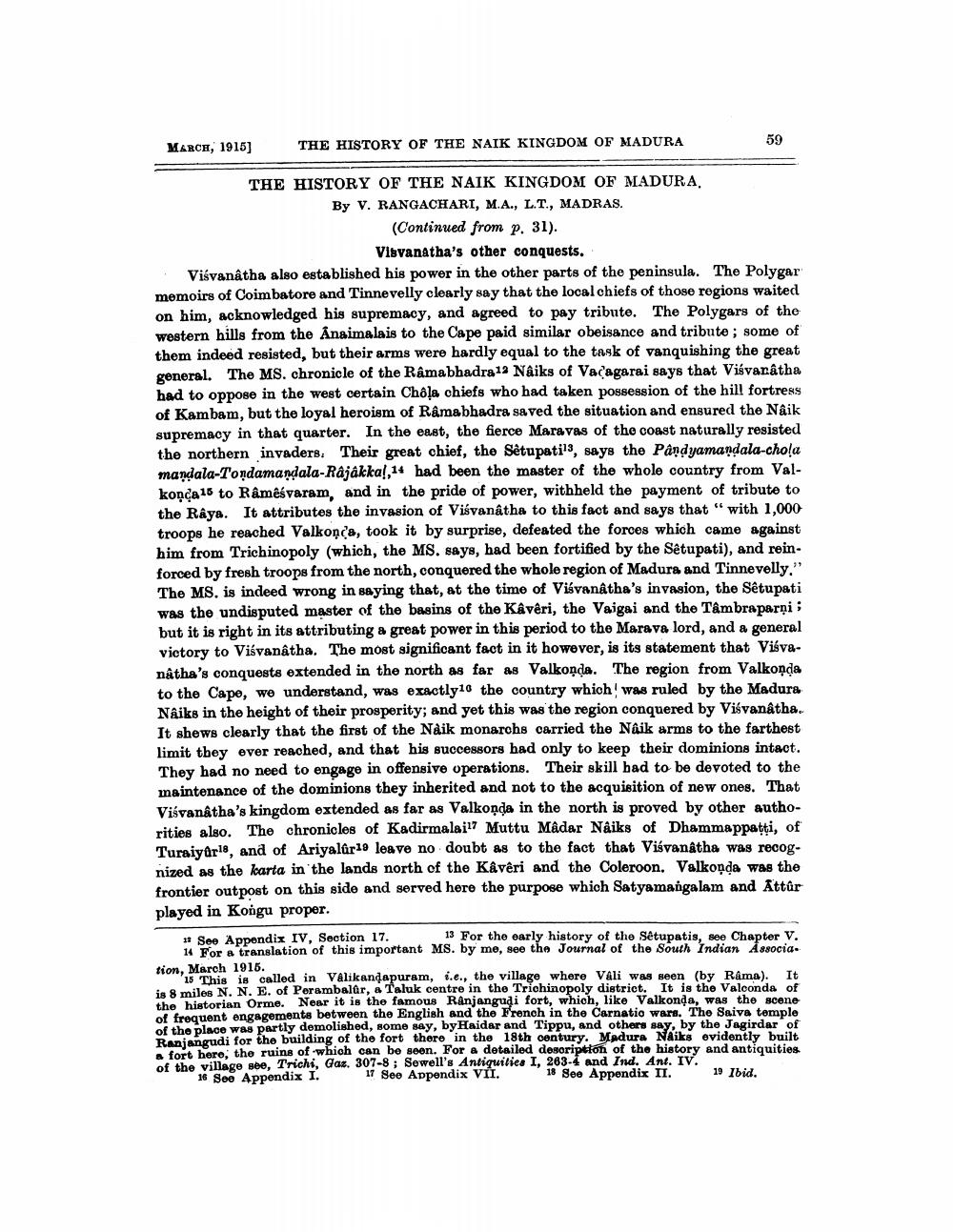________________
MARCH, 1915)
THE HISTORY OF THE NAIK KINGDOM OF MADURA
59
THE HISTORY OF THE NAIK KINGDOM OF MADURA,
By V. RANGACHARI, M.A., LT., MADRAS.
(Continued from p. 31).
Visvanatha's other conquests. Visvanatha also established his power in the other parts of the peninsula. The Polygar memoirs of Coimbatore and Tinne velly clearly say that the local chiefs of those regions waited on him, acknowledged his supremacy, and agreed to pay tribute. The Polygars of the western hills from the Anaimalais to the Cape paid similar obeisance and tribute ; some of them indeed resisted, but their arms were hardly equal to the task of vanquishing the great general. The MS. chronicle of the Ramabhadra 12 Naiks of Vacagarai says that Visvanatha had to oppose in the west certain Chola chiefs who had taken possession of the hill fortress of Kambam, but the loyal heroism of Râmabhadra saved the situation and ensured the Naik supremacy in that quarter. In the east, the fierce Maravas of the coast naturally resisted the northern invaders. Their great chief, the Setupati, says the Pând yamandala-chola mandala-Tondamandala-Râjákkal, 14 had been the master of the whole country from Valkonca 16 to Râmêśvaram, and in the pride of power, withheld the payment of tribute to the Râys. It attributes the invasion of Visvanatha to this fact and says that " with 1,000 troops he reached Valkona, took it by surprise, defeated the forces which came against him from Trichinopoly (which, the MS. says, had been fortified by the Setupati), and reinforced by fresh troops from the north, conquered the whole region of Madura and Tinnevelly.” The MS. is indeed wrong in saying that, at the time of Visvanatha's invasion, the Setupati was the undisputed master of the basins of the Kávéri, the Vaigai and the Tambraparni; but it is right in its attributing a great power in this period to the Marava lord, and a general victory to Visvanatha. The most significant fact in it however, is its statement that Visvanâtha's conquests extended in the north as far as Valkonda. The region from Valkonda to the Cape, we understand, was exactly 16 the country which was ruled by the Madura NÂiks in the height of their prosperity; and yet this was the region conquered by Visvanatha. It shews clearly that the first of the Ndik monarchs carried the Naik arms to the farthest limit they ever reached, and that his successors had only to keep their dominions intact. They had no need to engage in offensive operations. Their skill had to be devoted to the maintenance of the dominions they inherited and not to the acquisition of new ones. That Visvanatha's kingdom extended as far as Valkonda in the north is proved by other authorities also. The chronicles of Kadirmalai7 Muttu Mâdar Naiks of Dhammappatti, of Turaiyar18, and of Ariyalûr19 leave no doubt as to the fact that Visvanatha was recognized as the karta in the lands north of the Kåvêri and the Coleroon. Valkonda was the frontier outpost on this side and served here the purpose which Satyamangalam and Attür played in Kongu proper.
11 See Appendix IV, Section 17. 13 For the early history of the Setupatis, see Chapter V.
14 For a translation of this important MS. by me, see the Journal of the South Indian Associa. tion, March 1915.
"15 This is called in Valikandapuram, i.e., the village where Vali was seen (by Rama). It is & miles N. N. E. of Perambalor, a Taluk centre in the Triohinopoly district. It is the Valoonda of the historian Orme. Near it is the famous Ranjang of frequent engagements between the English and the French in the Carnatio wars. The Saiva temple of the place was partly demolished, some say, by Haidar and Tippu, and others say, by the Jagirdar of Ranjangudi for the building of the fort there in the 18th century. Madura Naiks evidently built
Tort hare the ruins of which can be seen. For & detailed dosoription of the history and antiquities of the village see, Trichi, Gax. 307-8; Sewell's Antiquitiea I, 263-4 and Ind. Ant. IV.
16 See Appendix I. 17 See Appendix VII. 18 See Appendix II.
ents between some say, by in the 18th Lorcription ofad. Ant. IV. 19 Ibid.




